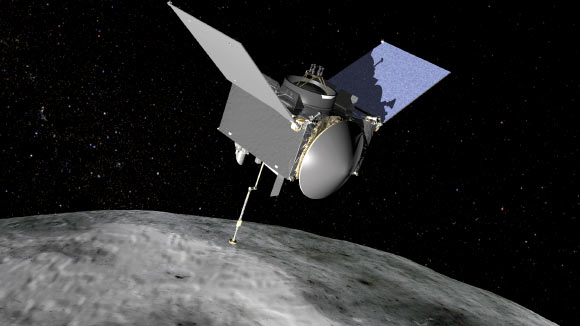At 2:43 p.m. EST (7:43 GMT) on December 31, 2018, NASA’s OSIRIS-REx spacecraft went into orbit around asteroid Bennu — setting new records for the smallest body ever orbited by a spacecraft and the closest orbit of a planetary body by any spacecraft.
OSIRIS-REx will circle Bennu about a mile (1.75 km) from its center. The comfortable distance is necessary to keep the orbiter locked to the asteroid, which has a gravity force only 5-millionths as strong as Earth’s.
The spacecraft is scheduled to orbit Bennu through mid-February at a leisurely 62 hours per orbit.
“Now that the OSIRIS-REx spacecraft is closer to Bennu, physical details about the asteroid will leap into sharper focus, and the spacecraft’s tour of this rubble pile of primordial debris will become increasingly detailed and focused,” OSIRIS-REx team members said.
One of the key objectives of this orbital phase is to get a better handle on Bennu’s mass and gravity, features that will influence the planning of the rest of the mission.
In the case of Bennu, scientists can only measure these features by getting OSIRIS-REx very close to the surface to see how its trajectory bends from Bennu’s gravitational pull.
“Our orbit design is highly dependent on Bennu’s physical properties, such as its mass and gravity field, which we didn’t know before we arrived,” said OSIRIS-REx’s flight dynamics system manager Dr. Mike Moreau, from NASA’s Goddard Space Flight Center.
“This orbital phase will help improve our detailed models for Bennu’s gravity field, thermal properties, orientation, and spin rate,” said Dr. Dan Wibben, OSIRIS-REx maneuver and trajectory design lead at KinetX Aerospace.
“This, in turn, will allow us to refine our trajectory designs for the even more challenging flight activities we will perform in 2019.”
The OSIRIS-REx team will resume science operations in February 2019.
At that point, the spacecraft will perform a series of close flybys of Bennu for several months to take high-resolution images of every square inch of the asteroid to help select a sampling site.
During the summer of 2020, the orbiter will briefly touch the asteroid’s surface to retrieve a sample.
The OSIRIS-REx mission is scheduled to deliver the sample to Earth in September 2023.








